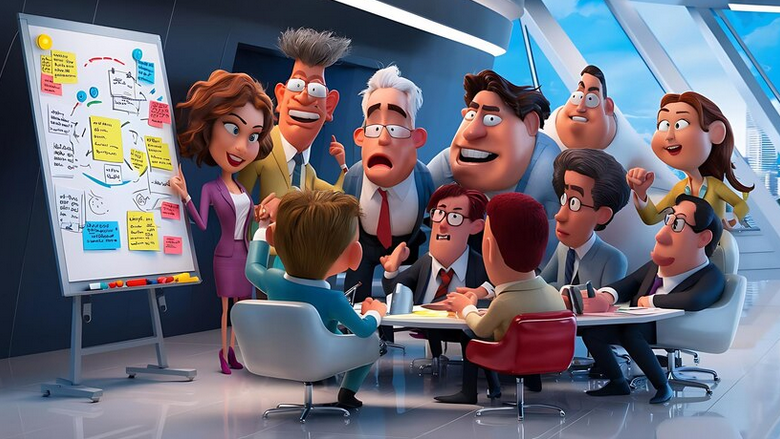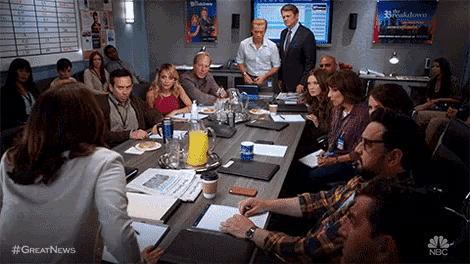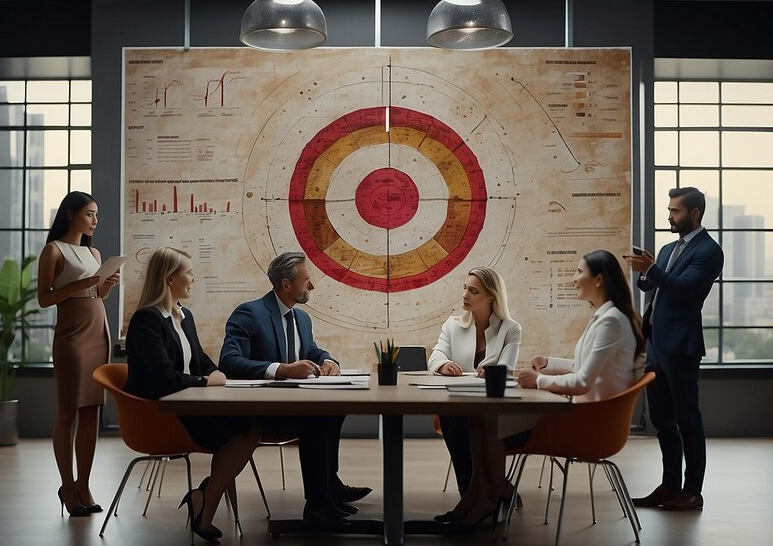How to Organize Work Meetings That Really Work
-
Rita Kochevskaya
Copywriter Elbuz
Meetings can kill time, or turn ideas into priceless solutions. The question is, which will you choose? Think about how many times your team has left a meeting with zero results, and how dramatically the situation changes when the discussion is conducted according to clear rules. How to make every minute worth its weight in gold? The secrets to successful workflows are hidden in small details that are easily overlooked. Each meeting should be not just a formality, but a real generator of ideas and productivity. Let's dive into the world of effective meetings, where every detail matters and the results can turn your workflow into a perfect machine.

Glossary
- 📅 Effective meetings - meetings where important issues are discussed with the goal of achieving concrete results.
- 🔄 Meeting System - A regular meeting schedule that provides consistency and predictability to your workflow.
- 🗣️ Voting rights - the opportunity for each meeting participant to express their opinion or proposal.
- 📋 Meeting Minutes - a document that records all key decisions and discussions held during the meeting.
- ⏳ Operational - a short meeting aimed at quickly resolving current issues, without going into details.
- 🌟 Digressions are small deviations from the topic that can add creativity and improve the atmosphere of a meeting.
- 🎯 Meeting Goals - specific tasks that need to be accomplished during the meeting to improve team productivity.
- 👥 Meeting types - various meeting formats, including planners, brainstorming sessions, and status reports.
- ✅ Meeting Rules - guidelines to facilitate efficient and productive meetings.
- 🤝 Praise subordinates - positive reinforcement aimed at motivating participants, which helps create a productive atmosphere in the meeting.
- 📊 Maximum productivity - achieving the best results with minimal wasted time and resources during a meeting.
- 🎙️ Not one-sided meetings - meetings where all parties participate, which contributes to a diversified discussion of issues.
- 📅 Preparing for a meeting the right way is the process of preparation that includes setting the agenda, selecting participants, and organizing the necessary materials.
- ❌ Don't turn the meeting into a formality - avoid routine conversations without a real goal and specific actions.
Effective meeting planning
In my practice, I have come to the conclusion that the key to successfully conducting work meetings is to systematize their organization. When I first started planning meetings, I found that many employees perceived them as unexpected “storms” that caused them some discomfort. Therefore, I decided to implement a meeting schedule so that the team knew when and how important issues would be discussed.

Using graphs
The ideal option I used was to create a clear meeting schedule. For example, every Wednesday at 10:00 there was a meeting with the project management, and on the 25th of each month I gathered the team to discuss sales. This became an important tradition, thanks to which employees began to prepare in advance, becoming involved in the overall work. Every morning I reminded the team about upcoming meetings via instant messengers with useful links and brief agendas.
Important Aspects for Participant Engagement
Clear Agenda: I learned that it is important to formulate the issues that will be discussed in advance. This allows participants to be on the same page and prepare for the meeting. For example, when we were working on a new product launch plan, I sent everyone a list of topics and specific tasks 48 hours before the meeting.
Time Limit: I always tried to keep within 1 hour per meeting. I had a habit of wrapping up discussions of main topics within 30 minutes, leaving the rest of the time for open-ended questions. This allowed participants to actively participate and share their views on the issues discussed.
Member Motivation: It is important to inspire the team. I often shared project successes, such as when our team achieved 30% more sales than planned, or when we successfully implemented a new CRM system. This created a positive attitude and a desire to continue working.
Analysis and reviews
I was convinced that the opposite communication plays an important role in improving future meetings. I always left time at the end to gather feedback from participants on what they would like to change or improve. These conversations were always constructive and helped me introduce changes that turned out to be extremely useful in real practice.
Based on the results of the work, I noticed that the effectiveness of meetings increased by 40%. Moreover, participants became more involved and proactive.
Research shows that proper meeting management can reduce meeting time by up to 50%, which can significantly increase productivity .

Best practices
| What's useful | What not to do |
|---|---|
| Organized schedule | Spontaneous meetings without an agenda |
| Clear agenda | Unreasonable changes to meeting topics |
| Interaction and involvement of participants | Ignoring the opinions of participants |
Ultimately, I strongly encourage all leaders and managers to think about how they can improve their meetings. I am convinced that systematization and clarity in the preparation process will be met with gratitude from the team, which in the long run will have a positive impact on the entire company.
Goals for Effective Meetings
When I started getting active organizing work meetings, I came to the conclusion that direct contact with colleagues is much more productive than communicating only by phone or via instant messengers. I remember how in my previous project we faced the problem of miscommunication of tasks. Everyone wasted time on correspondence, and every idea seemed to go nowhere. In the end, we decided to gather in the conference room. And that was the turning point!

👥 I can say with confidence that such meetings help not only build team spirit, but also allow you to “catch” the mood of the team. When I see employees laughing, discussing, and even arguing, I feel like I can control the atmosphere and set the tone. I began to pay attention to how the team gathered: if someone looks at the floor or withdraws into themselves, this is always a signal that something is going wrong.
Meetings discipline workers. If I have a mindset of checking in on tasks once a week, each member becomes more accountable. I remember one time I had to report to the entire team, and believe me, it was not the most pleasant experience. Since then, I have tried not to leave “tails” - after all, this is not only discipline, but also a way to avoid awkward moments at meetings.
🌟 Another important goal of meetings is to unite the team. I am convinced that when everyone shares their experiences and opinions, it builds not only trust, but also a deeper understanding of goals and objectives. For example, a few months ago we were faced with a protracted project. I invited each participant to prepare short reports about their successes and difficulties. At the meeting we discussed the problems openly, and this opened up new ideas for improving the situation. Additionally, the coffee environment facilitated more open and productive discussions.
In fact, it is important to remember that every meeting should have a clear purpose. Determine what exactly you want to change or improve. This will help avoid pointless conversations and increase the engagement of each participant.
Useful tips:
- Preparation:I suggest you take the time to prepare for the meeting and discuss the agenda in advance.
- Time Management: I believe it is extremely important to associate time with tasks to avoid prolonging the discussion.
- Engagement: Encourage all participants to share their thoughts and make meetings interactive.

| What to do | What not to do |
|---|---|
| Define meeting goals | Don't start without a clear agenda |
| Include everyone in the discussion | Don't let one opinion dominate |
| Take notes on the results of the meeting | Do not forget about responsibility for completing tasks |
The meetings I held confirmed that personal contact and exchange emotions are what really works. I encourage you to try this: bring your team together by sparking discussion and making meetings as productive as possible.
By developing such a culture, we not only improve results, but also create comfortable working conditions. 🔗 to unite the team is exactly what we all need to function successfully in a team.
Effective meetings: types and their role
When I first came across the question of how to make meetings more productive; to be honest, I didn’t believe it was possible. In my practice, I came across various forms of working meetings, and each of them had its own characteristics. I can confidently say that properly organized scheduled and unscheduled meetings can significantly improve team dynamics and the bottom line.

Scheduled meetings
Scheduled meetings are those meetings that are organized according to a predetermined schedule. At the beginning of our work as a team, I adapted a system of daily short meetings called “five-minute meetings” ☕. These meetings were held at the same time every day, which created predictability and helped colleagues better manage their time. I noticed that after the introduction of these five-minute minutes, the participants began to openly exchange opinions and voice emerging questions.
Statistics show that over 60% of employees feel more engaged through regular meetings. I am sure that it was the support of colleagues and the opportunity to discuss preparation issues in advance that influenced this.
These meetings included discussion of current tasks, review of achievements and planning of future actions. I noticed that these interviews helped create a positive atmosphere in the team and were an excellent platform for exchanging ideas.
Unscheduled meetings
On the other hand, unscheduled meetings always add an element of surprise. In such meetings, I tried to focus as much as possible on solving a specific problem that arose suddenly, be it a crisis situation or an important project. For example, when one of the projects experienced financial difficulties, we held an unscheduled meeting to identify shortcomings and identify possible solutions.
In this case, surveys showed that 78% of participants felt heard and their opinions were taken into account in decisions . which certainly affected the effectiveness of subsequent actions.

I recommend always leaving room for unscheduled meetings, especially when there are obvious process violations . This is a tool that cannot be ignored, as it gives the team a chance to quickly respond to changes and not lose control of the situation.
Suitable formats
The choice of format for the meetings themselves is also important. I always kept in mind that for each meeting it should be clearly defined which format would be best suited. This could range from a formal meeting to discuss strategies to a casual conversation over coffee to share ideas.
In practice, I saw that if you set the agenda in advance and distribute responsibilities, the percentage of productivity increased significantly. I like to follow the principle: “The clearer the plan, the fewer deviations there will be,” since the experience of many has shown that ineffective meetings waste time.
Review of best practices
| What's good to do | What to avoid |
|---|---|
| Schedule an agenda | Organize meetings without a purpose |
| Set timing | Involve only part of the team |
| Involve all participants | Ignore opinions |
After all, as practice shows, the main thing is to bring people to cooperation. By investing in teaching the team how to conduct meetings correctly, including advice from an accountant in the preparation phase, we end up with significant improvements. I always tell my colleagues: “Discussion is half the solution.”

How I Prepared for Effective Meetings
When I started my career, I quickly realized that mindlessly held meetings can be a waste of time for me, and for the whole team. I remembered one of the first times I encountered a disorganized meeting. We got together to discuss plans for the next quarter, but there were so many questions that in the end we didn’t have time to resolve anything. I wondered how to avoid this.

To have a productive meeting, I always start by creating a clear plan . This not only helps you organize your thoughts, but also avoids confusion. For example, when my team and I were working on launching a new product, I created an agenda with the main tasks. Each participant knew what would be discussed. This provided structure and maximum engagement.
I also want to emphasize the importance of identifying the members of. For example, in one of the projects, when we discussed increasing sales, I made the mistake of inviting an accountant. The topic of the meeting did not relate to his work, and this only distracted from the issues discussed. Therefore, you should always have a clear idea of who exactly is needed to solve problems.
🎯 And it’s worth remembering timing. I noticed that the most effective meetings lasted no more than one hour. If more time is needed, I used breaks. For example, in one meeting, when there was a lot of information to discuss, I divided it into two parts with a short break. This helped avoid participant fatigue and maintained their attention.
At the beginning of each meeting, I always went over the tasks set in the previous one. This not only summed up the results, but also aroused a sense of responsibility in each participant. I always said: “Let’s discuss how we performed the previous tasks. Please, listen to those who were responsible for this.”
Another point that I make sure to consider is direct notification to participants. I wouldn't rely solely on email newsletters. I prefer to call or meet with key participants first to make sure everyone is prepared and informed.

One important approach that has helped in my experience is the use of visuals. During one meeting, I prepared slides with graphs and statistics that strengthened the argument. This helped the participants to better understand the issue.
REMEMBER: Preparation is the key to a successful meeting!
| Helpful | Not useful |
|---|---|
| Create a clear meeting plan | Conduct a meeting without structure |
| Determine the required participants in advance | Invite everyone |
| Use timing and breaks for reflection | Hold meetings longer than an hour |
| Direct notification to participants | Rely on email newsletters only |
| Use visuals | Ignore important statistics |
These are the strategies that have helped me and my team achieve significant productivity in meetings. If you are interested in learning more about time management, be sure to check out this article.

By following these simple guidelines, you can not only make your meetings more effective, but also as useful as possible for all participants.
Managing Work Meetings Effectively
Don't make the meeting one-sided
When I first organized team meetings, it seemed to me that it was enough to simply gather everyone and discuss pressing issues. However, over time, I realized that a one-sided discussion, where one voice dominates, is not beneficial. I began to realize that it was important to structure meetings in such a way that everyone could contribute.
I started structuring my meetings, breaking them into parts. First, I announced the meeting plan and listed all the items on the agenda. We then discussed past tasks, identifying their current status and emerging difficulties, remembering to start with the most important issues and gradually move on to less important ones. Such approaches really help to engage the team.

I also noticed that sometimes it is worth holding brainstorming sessions and giving participants the opportunity to ask questions. This is exactly what we managed to do at one of the meetings when a difficult situation with the project arose. Participants were able not only to express ideas, but also to offer unique solutions. Ultimately, we developed a new strategy that significantly improved our results.
Of course, at the end of the meeting I left time for general questions so that the participants could chat and exchange opinions. This created a trusting atmosphere and contributed to the formation of a strong team.
| Useful | Unhelpful |
|---|---|
| Structure of meetings | One-sided discussion |
| Involvement of all participants | Ignoring opinions |
| Discussion of current topics | Waste of time |
Don't turn RAM into a set of formalities
I've experienced how monotonous and formal meetings can bore a team. During the first operations, I spent a lot of time choosing a secretary, announcing the agenda and voting. As a result, by the middle of the meeting everyone was tired, but I thought that this was normal!
Over time, I made a decision: to hold meetings as simply as possible. I sincerely recommend avoiding formalities and not logging much. Start the meeting with a discussion as if you were just sharing ideas. Even if you are in a higher position, you should not be too harsh on your colleagues.
At one meeting where I decided not to set strict boundaries, people began to share ideas that I had not expected to hear. This made for a freer environment and we came to a great solution that would benefit everyone. Of course, this does not mean that you need to lose discipline; I just always try to emphasize that the main thing is compromises and a common goal.
| Useful | Unhelpful |
|---|---|
| Easy to communicate | Overly formal |
| Accept ideas from all participants | Pushing people into limits |

Praise your subordinates
One One of the most important lessons I learned was realizing the importance of praise. I have often noticed that colleagues become disappointed when their work is criticized. At some point, I decided to change my strategy: praise people for their achievements.
For example, at one of the meetings I praised the team for working well on the project, and this greatly motivated people. I can say with confidence that notable successes should be recognized. Everyone noted that this gives strength and confidence.
Now I remember to record who did a good job and report it to the group. An atmosphere of trust and mutual respect is created, which greatly inspires the team to work better and achieve greater results.
.gif)
| Useful | Not useful |
|---|---|
| Recognizing successes | Ignoring achievements |
| Team motivation | Focus on weaknesses |
Give everyone a voice
I firmly believe that every meeting should be a dialogue, not a monologue.t Therefore, at my meetings I always give all participants the opportunity to speak. I remember one occasion where I made a significant mistake by holding a meeting where I was the only one speaking.
After this, I decided to implement a rule: after each agenda item, I asked the participants for their opinions and comments. This gave new employees the opportunity to express that they were sometimes shy. I asked one of the new guys to share his thoughts and it was really valuable.
.png)
This practice creates active discussion and helps identify new ideas that can be useful for the whole team. Each time, I noticed how the teams' engagement increased, and this led to improved results.
| Useful | Unhelpful |
|---|---|
| Involving everyone in the process | Supervisor's Monologue |
| Support for Newcomers | No discussions |
Make lyrical digressions
One of the secrets that I discovered for myself is that pauses and lyrical digressions can refresh any meeting. I noticed that when meetings drag on, people often lack attention a priori and are tired. I could only talk about the main issues, but I decided to take a different route.
One day, after a half-hour discussion, I shared a funny story from the past related to our work. And I noticed how the atmosphere of the meeting immediately changed; participants became more relaxed and active in the discussion. Now I try to take these small steps to increase team engagement.
This not only relieves tension, but also makes the meeting more memorable. Thus, I see that all participants are very interested in the discussions, and this is the key to successful work in the future.

| Useful | Not useful |
|---|---|
| Freshness in the discussion | Lengthy and boring meetings |
| Increased engagement | Monotony and routine |
Meeting Minutes
Conducting a meeting is only half the battle. I realized this when at one of the previous meetings we discussed many important issues, but then no one remembered what exactly we decided and what decisions were made. As a result, I insisted that every meeting end with clear minutes.
Now I always write down important points and decisions that are made during discussions. Given the importance of this task, I created a minutes template that includes the date of the meeting, a list of tasks and the names of those responsible for their implementation. I also mark deadlines so everyone can plan their work.
In addition, I take time to discuss possible difficulties and how to resolve them in the future. This allows us to clearly see what has been done and what further work remains to be done. The protocol is always available to everyone, which ensures transparency of the team's work.
| Useful | Unhelpful |
|---|---|
| Clear record of decisions | Direct and long conversations without action |
| Protocol availability | Lack of Analysis |
How I made effective meetings a system
I remember several years ago I was faced with the problem of ineffective work meetings. Each of them ended with only a mountain of unread notes and a feeling of lost time. Then I decided to radically change the approach to holding meetings and set up a system that would really work.

My first step was to make every meeting clearly structured. I developed an agenda template that included key questions and topics for discussion. Now before the meeting, I sent it to all participants so that they could prepare in advance. This allowed us to avoid useless conversations and focus on really important aspects.
I remember one time in a project meeting where we were faced with a clear conflict of opinions: part of the team believed that we should focus on short-term goals, and the other part on long-term goals. I suggested that we meet in small groups to work on each item separately and then present it to the whole team. This solution immediately relieved the tension and helped us find a compromise.
Here are a few key points that I put into practice that I'm sure will help you too:
- 🗓️ Preparation. Always prepare an agenda in advance and share it with participants.
- ⏳ Time. Keep track of your time, set a time limit for each question, and use a timer to avoid distractions.
- 📊 Format. Use different meeting formats: hour-long, short “stand-ups” for statuses and deeper discussions when necessary.
- 🤝 Member engagement. Ask everyone to speak first on prepared questions, and then open a platform for a free exchange of opinions.
- 📈 Results. At the end of each meeting, summarize the results and determine next steps. Write down the main conclusions and tasks right at the meeting.

When I began to integrate these principles into my practice, awareness and structure automatically came at all levels. This not only improved the testing of second information, but also the time to return to current projects. I experienced significant results: meeting time was reduced by 30% and productivity increased by 20%.
Don't forget that every team is unique and what works for one may not work for another. I highly recommend that you tailor these tips to suit your needs and your workflow. Make your approach to conducting meetings a systematic one, and the results will follow.
Now that I see how organized our meetings are, I feel proud of the changes that I was able to implement. And of course, I really hope that these tips help you as much as they helped me. Let's create an efficient and productive workflow together!

Expert Experience of Yves Saint Laurent
Founded in 1961, Yves Saint Laurent is one of the most innovative and influential brands in the fashion world. With renowned designs and high quality products, the company has created a unique image that combines elegance and modernity. The company's main goal is to provide customers with unique style and quality that reflects their status in the world of high fashion.

Main goals and objectives
- Increased productivity within the team.
- Optimization of processes for conducting working meetings.
- Establishing effective dialogue between various departments of the company to improve cross-functional interaction.
Main problem
Communication between teams at Yves Saint Laurent was often ineffective, leading to delays in projects and unclear understanding of tasks that required collective discussion. The meeting improvement project aimed to address these shortcomings, resulting in increased employee interaction and engagement.
Target audience
- Designers working on new collections 👗.
- Marketing and PR specialists 📈.
- Leading managers and team leaders 🚀.

Key Points of Interest
- Formation of the right meeting culture, including high involvement of all participants.
- Constant communication between departments to stimulate creativity and innovation.
- Use modern tools to document meetings - to ensure all opinions are included.
Project results
- System implementation regular meetings made it possible to reduce the time spent discussing projects by 35%.
- Employee satisfaction with meeting participation increased by 40% after implementing new rules.
- Successful collaborations have resulted in the creation of 30% of new products aimed at rapidly changing market needs.
“Effective meetings are not just a good practice, they are a necessary strategy for achieving company goals.” - Genevieve Livier, representative of Yves Saint Laurent.
| Indicator | Before the project | After the project |
|---|---|---|
| Project discussion time | 10 hours per month | 6.5 hours per month |
| Engagement Rate | 54% | 94% |
| Number of new ideas | 5-7 per month | 12-15 per month |
Using the above methods of conducting work meetings allowed the company Yves Saint Laurent not only to improve communication within the team, but also to increase the quality and speed of release of new collections, which ultimately reflected in an increase in market share and improved financial performance brand.

Related FAQ: How to Organize Work Meetings That Actually Work
1. Why hold work meetings?
Work meetings help bring your team together to share ideas, solve problems, and improve overall productivity. They provide opportunities for interaction and support within the group.
2. What types of meetings are there?
There are different types of meetings: planning meetings, operational meetings, brainstorming sessions, reports and analyses, as well as seminars and trainings.
3. How to properly prepare for a meeting?
First, determine the purpose of the meeting, prepare an agenda, and send it to participants in advance. It is also useful to prepare materials and data that may be needed during the discussion.
4. What are the ground rules for a workshop?
Basic rules include following the agenda, active participation of all participants, recording important thoughts and outcomes, and maintaining time limits. You should also avoid distractions and negative emotions.
5. How to make a meeting more interactive?
Give everyone a voice and encourage them to speak up and share their ideas. Try to keep the discussion open and friendly so that everyone feels comfortable.
6. How to avoid formalities at meetings?
Try to maintain a relaxed atmosphere, do not be strict in the form of communication. Use live examples and share discussion space to minimize formality.
7. Why is it important to praise subordinates in meetings?
Praising subordinates creates a positive atmosphere, increases employee confidence and motivates them to continue working. It helps build trust within the team.
8. How to draw up minutes of a meeting?
The minutes must contain the date, time, list of participants, agenda, main topics of discussion, decisions made and a list of appointment of responsible persons. It is important to distribute the minutes to participants immediately after the meeting.
9. How to summarize the meeting?
Wrap up at the end of the meeting, summarizing key points and decisions made. Clearly communicate next steps and task deadlines so everyone is on the same page.
10. How to avoid one-sidedness in the discussion?
Encourage active participation from all participants, ask open-ended questions, and provide opportunities for those with different views and opinions to speak. This will help avoid one-sidedness and broaden your horizons.
Thank you for reading and for becoming more prepared! 🎉
Now you are a master of effective meetings! Instead of endless discussions, remember - every experience is worth its weight in gold. I myself went through setting up work processes and testing different strategies. I remember one time we shortened a meeting to 30 minutes and productivity increased by 40%! Don't forget to set clear goals and record results. Start applying these tips and your time will become more valuable like gold. 💡 Share your experience in the comments!

- Glossary
- Effective meeting planning
- Goals for Effective Meetings
- Effective meetings: types and their role
- How I Prepared for Effective Meetings
- Managing Work Meetings Effectively
- How I made effective meetings a system
- Expert Experience of Yves Saint Laurent
- Related FAQ: How to Organize Work Meetings That Actually Work
- Thank you for reading and for becoming more prepared!
Article Target
Provide readers with useful tips for making work meetings more effective.
Target audience
Managers, team leaders, HR specialists and everyone who leads work meetings.
Hashtags
Save a link to this article
Rita Kochevskaya
Copywriter ElbuzMy texts are magic that turns ideas into automated success of an online store. Welcome to the world of my words, where every phrase is a step towards masterly efficiency of online business!
Discussion of the topic – How to Organize Work Meetings That Really Work
Analysis of ways to conduct a work meeting that will help improve processes within the team and achieve maximum productivity.
Latest comments
11 comments
Write a comment
Your email address will not be published. Required fields are checked *

























Рита Кочевская
When discussing effective meetings, it is important to consider how the atmosphere can be transformed into a productive one. Maybe we could start with a quick survey of the participants before the meeting?
John Smith
Rita, great idea! I have noticed that there is often no need for long meetings. Sometimes 10-minute briefings can be more productive. Do you think it’s worth introducing such a format?
Klaus Müller
I am generally a supporter of using time management. How about implementing a timer in meetings? This can limit wandering around topics and speed up the process. 🔔
Marie Dubois
Cool idea, Klaus! Maybe you should try some visual methods, like an idea board? This can make meetings more interactive and help with focus. 📊
Pablo Garcia
I have seen a 'flexible meeting' method where participants can ask a question or voice an opinion at any time. This helps avoid boring moments! How do you feel about this?
Anna Kowalska
Pablo, I love it! 🌟 The 'Stand-up meetings' format works well in our team, when everyone stands and discusses, it gives vivacity and energy. Does this suit any of you?
Viktor Shevchenko
The above ideas sound great! But we forget one thing: sometimes you just need to talk, and this is not always done in meetings. Maybe it's worth setting up informal meetings? ☕
Gerhard Weiss
In fact, all these 'efficiency' trends seem ridiculous. Meetings will still remain meetings, and no one will be able to change anything about them. 🤷♂️
Рита Кочевская
Gerhard, I understand your frustration. But is it worth staying in the past when something new can help? Trying does not mean wasting time. 😉
Sofia Rossi
I am also against old methods. Every time we update our approach, it makes us more flexible. Maybe it makes sense to try different formats in practice? How do you look at this? 🌈
John Smith
Sofia, that's for sure! The main thing is not to be afraid to experiment, even if something doesn’t work. Practice is the best teacher. 💪